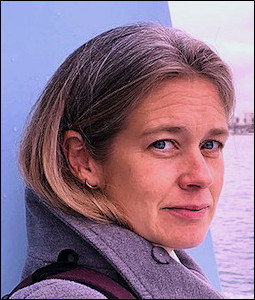Department of English Language and Literature
Directory
Emily Manetta
| Title: | Professor Director of Linguistics Program |
| Department: | English Language and Literature; Linguistics Program McCausland College of Arts and Sciences |
| Email: | emanetta@mailbox.sc.edu |
| Phone: | 803-577-8312 |
| Office: | HOB 616 |
| Resources: |

Education
PhD in Linguistics, University of California, Santa Cruz, 2006
BA in Linguistics, Islamic Studies, Swarthmore College, 2000
Specialization
• Theoretical syntax
• Indic languages (Hindi-Urdu, Kashmiri, and Romani)
• Wh-questions and displacement to the clausal peripheries, ellipsis phenomena, and
verb-second word orders
• Romani language use and endangerment in the Mediterranean
• Analysis of health care conversations in collaboration with the Vermont Conversation Lab
Publications
Books
• 2020. Rarely-used structures and lesser-studied languages: Insights from the margins. Series:
Routledge Studies in Linguistics. Routledge. [publisher's site]
• 2011. Peripheries in Kashmiri and Hindi-Urdu: The Syntax of Discourse-Driven
Movement. John Benjamins. [publisher's site]
Articles
• 2023. “It was just so hard”: ineffability just as a mixed expressive. With Ian Bhatia. Glossa: a journal of general linguistics 9(1). pp. 1–26. DOI: https://doi.org/10.16995/glossa.10362
• 2021. Verb-second and the verb-stranding verb-phrase ellipsis debate”. Glossa: a journal of general linguistics. 6(1): 135, pp. 1–35. DOI: https://doi.org/10.16995/glossa.5704
• 2021. “Cognitive Grammar” in Stanlaw, James (ed.) International Encyclopedia of Linguistic Anthropology. John Wiley and Sons. DOI: 10.1002/9781118786093.
• 2020. Expanding the Typology of V2 VPE: The Case of Kashmiri. In Wolfe, Sam and Rebecca
Woods (eds) Rethinking Verb Second. Oxford University Press: 723-744.
• 2019. Verb Phrase Ellipsis and complex predicates in Hindi-Urdu. Natural Language and Linguistic Theory. 37: 3, 915-953.
• 2018. The structure of complex predicates in Hindi-Urdu: evidence from verb-phrase ellipsis.
In Sharma, Ghanshyam and Rajesh Bhatt (eds) Trends in Hindi Linguistics. Berlin: Mouton de Gruyter: 47-84.
• 2018. We say 'How high?': Adverbs, negation, and verb movement in a verb-final language.
In Merchant, Jason, Line Mikkelsen, Deniz Rudin & Kelsey Sasaki (eds.) A reasonable way to proceed: Essays in honor of Jim McCloskey. Linguistics Research Center, Santa Cruz, CA: 211-228.
• 2017. Syntactic Identity in Sluicing: Sprouting in Kashmiri Causatives. In Kramer, Ruth,
Jason Ostrove, and Joseph Sabbagh (eds). Asking the right questions: Essays in Honor of Sandy Chung. LRC: University of California, Santa Cruz.
• 2016. "Ellipsis in wh-in-situ languages: deriving apparent sluicing in Hindi-Urdu and Uzbek".
with Vera Gribanova. Linguistic Inquiry 47:4, 631-668.
• 2016. Verb Position and Question Markers in a Verb-Second Language. Linguistic Analysis
40/3-4: 379-414.
• 2016. Formal Syntax, Semantics and Morphology of South Asian Languages (co-edited with Ayesha
Kidwai). Special Issue of Linguistic Analysis
• 2014. The shape of the causative verbal domain: evidence from Kashmiri. Syntax. 17:3 235-268.
• 2012. Reconsidering rightward scrambling: Postverbal constituents in Hindi-Urdu. Linguistic
Inquiry. 43:1, 43-74.
• 2011. Journey Into paradise: Tajik representations of Afghan Badakhshan. Central Asian Survey. 30:3, 363-379.
• 2010. Wh-expletives in Hindi-Urdu: the vP Phase. Linguistic Inquiry. 41:1, 1-34.
• 2009. Feature Stacking: The Kashmiri Periphery. The Fifth Asian GLOW Conference Proceedings.
Central Institute of Indian Languages, 243-267.
• 2007. Unexpected Left Dislocation: an English Corpus Study. Journal of Pragmatics. 'Formal
and Philosophical Aspects of Pragmatics' 39:5